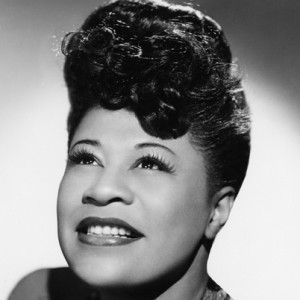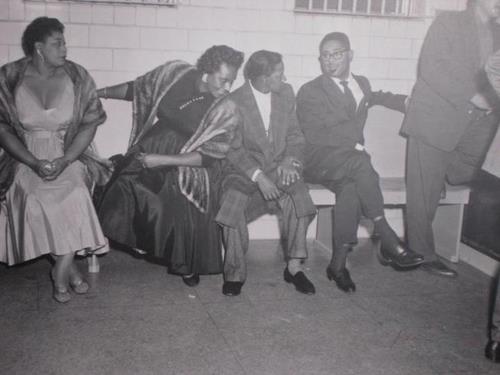So Apparently Ella Fitzgerald Was Locked Up As A Teenager…
 I never knew this but it seems that Ella Fitzgerald spent a year of her life as a teen at a girls’ reformatory in New York. She never spoke about this period of her life. I stumbled upon this information as part of my ongoing research about Billie Holiday.
I never knew this but it seems that Ella Fitzgerald spent a year of her life as a teen at a girls’ reformatory in New York. She never spoke about this period of her life. I stumbled upon this information as part of my ongoing research about Billie Holiday.
An article by Nina Bernstein appeared in the New York Times in 1996 which unearths this unknown period of Fitzgerald’s life:
The unwritten story survives in the recollections of former employees of the New York State Training School for Girls at Hudson, N.Y., and in the records of a government investigation undertaken there in 1936, about two years after Miss Fitzgerald left. State investigators reported that black girls, then 88 of 460 residents, were segregated in the two most crowded and dilapidated of the reformatory’s 17 “cottages,” and were routinely beaten by male staff.
At a time of renewed calls for institutions to rescue children from failed families, this lost chapter in the life of an American icon illuminates the gap between a recurrent ideal and the harsh realities of the child welfare system.
Like Miss Fitzgerald, most of the 12- to 16-year-old girls sent to the reform school by the family courts were guilty of nothing more serious than truancy or running away. Like today’s foster children, they were typically victims of poverty, abuse and family disruption; indeed, many had been discarded by private foster care charities upon reaching a troublesome puberty.
When Thomas Tunney, the institution’s last superintendent, arrived in 1965 and tried to bring back former residents to talk to the girls of his own day, he learned that Miss Fitzgerald had already rebuffed invitations to return as an honored guest.
“She hated the place,” Mr. Tunney said from his home in Saratoga Springs, where he retired some years after the institution closed in 1976. “She had been held in the basement of one of the cottages once and all but tortured. She was damned if she was going to come back.”
Not in the Choir
A more generous image of Miss Fitzgerald’s experience there was painted by E. M. O’Rourke, 87, who taught English at the school in the 1930’s and remembers Miss Fitzgerald as a model student. “I can even visualize her handwriting — she was a perfectionist,” she recalled. There was a fine music program at the school, she said, and a locally celebrated institution choir.
But Ella Fitzgerald was not in the choir: it was all white.
“We didn’t know what we were looking at,” Mrs. O’ Rourke said. “We didn’t know she would be the future Ella Fitzgerald.”
She did sing in public at least once while she was at the reformatory, according to Beulah Crank, who later worked as a housemother there. Mrs. Crank, 78, said she was with her parents at the A.M.E. Zion Church in Hudson the day Miss Fitzgerald performed with a few other black girls from the school; she would have been no more than a year away from her legendary victory in a talent contest at Harlem’s Apollo Theater.
“That girl sang her heart out,” Mrs. Crank remembered.
Gloria McFarland, director of psychology at the reformatory from 1955 to 1963, found Miss Fitzgerald’s record in the musty files. “She was a foster care kid when she came,” said Dr. McFarland. “She was paroled to Chick Webb’s band.” Later, the institution’s old juvenile records were destroyed by order of the state.
All her life, Miss Fitzgerald was intensely reluctant to talk about her past. As recently as 1994, when this reporter first stumbled on evidence that she had been at the school, Miss Fitzgerald kept her silence.
Read the rest of the article here.
This news about Ella Fitzgerald’s experiences in a reform school is particularly relevant in light of last week’s revelations about the Dozier Reform School. The Tampa Bay Times reported that:
Sen. Bill Nelson on Wednesday called on the Department of Justice to assist a team of anthropologists and archaeologists from the University of South Florida that has been investigating the deaths of nearly 100 children at Florida’s oldest reform school, the now-shuttered Dozier School for Boys outside the Panhandle town of Marianna.
This sounds truly ominous. The stories that have emerged from early to mid 20th century reform schools have been terrifying. It’s amazing that after enduring such difficult experiences so many were able to become productive and contributing members of society. This was certainly the case for Ella Fitzgerald as the photograph below illustrates. She and Dizzy Gillespie are captured awaiting arrest in Houston, Texas in 1955. It appears that reform school did not dampen Ms. Fitzgerald’s commitment to social justice.

